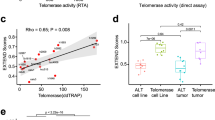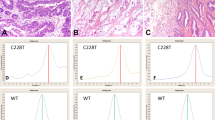Abstract
Activation of telomerase, the enzyme that synthesizes the telomere ends of linear chromosomes, has been implicated in human cell immortalization and cancer cell pathogenesis. Enzyme activity is undetectable in most normal cells and tissues, but present in immortal cells and cancer tissues1,2,3. While expression of TERC, the RNA component of telomerase, is widespread4,5,6, the restricted expression pattern of TERT, the telomerase catalytic subunit gene, is correlated with telomerase activity7,8,9, and its ectopic expression in telomerase-negative cells is sufficient to reconstitute telomerase activity10,11,12 and extend cellular lifespan13. We have used in situ hybridization to study TERT expression at the single-cell level in normal tissues and in various stages of tumour progression. In normal tissues, including some that are known to be telomerase-negative, TERT mRNA was present in specific subsets of cells thought to have long-term proliferative capacity. This included mitotically inactive breast lobular epithelium in addition to some actively regenerating cells such as the stratum basale of the skin. TERT expression appeared early during tumorigenesis in vivo, beginning with early pre-invasive changes in human breast and colon tissues and increasing gradually during progression, both in the amount of TERT mRNA present within individual cells and in the number of expressing cells within a neoplastic lesion. The physiological expression of TERT within normal epithelial cells that retain proliferative potential and its presence at the earliest stages of tumorigenesis have implications for the regulation of telomerase expression and for the identification of cells that may be targets for malignant transformation.
This is a preview of subscription content, access via your institution
Access options
Subscribe to this journal
Receive 12 print issues and online access
$209.00 per year
only $17.42 per issue
Buy this article
- Purchase on Springer Link
- Instant access to full article PDF
Prices may be subject to local taxes which are calculated during checkout




Similar content being viewed by others
References
Counter, C.M., Botelho, F.M., Wang, P., Harley, C.B. & Bacchetti, S. Stabilization of short telomeres and telomerase activity accompany immortalization of Epstein-Barr virus-transformed human B lymphocytes . J. Virol. 68, 3410–3414 (1994).
Kim, N.W. et al. Specific association of human telomerase activity with immortal cells and cancer. Science 266, 2011–2013 (1994).
Harley, C.B. et al. Telomerase, cell immortality, and cancer. Cold Spring Harb. Symp. Quant. Biol. 59, 307–315 (1994).
Feng, J. et al. The RNA component of human telomerase. Science 269, 1236–1241 (1995).
Avilion, A.A. et al. Human telomerase RNA and telomerase activity in immortal cell lines and tumor tissues. Cancer Res. 56, 645–650 (1996).
Blasco, M.A., Funk, W., Villeponteau, B. & Greider, C.W. Functional characterization and developmental regulation of mouse telomerase RNA. Science 269, 1267–1270 (1995).
Meyerson, M. et al. hEST2, the putative human telomerase catalytic subunit gene, is up-regulated in tumor cells and during immortalization. Cell 90, 785–795 (1997).
Nakamura, T.M. et al. Telomerase catalytic subunit homologs from fission yeast and human. Science 277, 955–959 ( 1997).
Kilian, A. et al. Isolation of a candidate human telomerase catalytic subunit gene, which reveals complex splicing patterns in different cell types. Hum. Mol. Genet. 6, 2011–2019 ( 1997).
Weinrich, S.L. et al. Reconstitution of human telomerase with the template RNA component hTR and the catalytic protein subunit hTRT. Nature Genet. 17 , 498–502 (1997).
Nakayama, J. et al. Telomerase activation by hTRT in human normal fibroblasts and hepatocellular carcinoms. Nature Genet. 18, 65–68 (1998).
Counter, C. et al. Telomerase activity is restored in human cells by ectopic expression of hTERT (hEST2), the catalytic subunit of telomerase. Oncogene 16, 1217–1222 ( 1998).
Bodnar, A.G. et al. Extension of life-span by introduction of telomerase into normal human cells . Science 279, 349–352 (1998).
Shay, J.W. & Bacchetti, S. A survey of telomerase activity in human cancer. Eur. J. Cancer 33, 787–791 (1997).
Harrington, L. et al. Human telomerase contains evolutionarily conserved catalytic and structural subunits. Genes Dev. 11, 3109–3115 (1997).
Harle-Bachor, C. & Boukamp, P. Telomerase activity in the regenerative basal layer of the epidermis inhuman skin and in immortal and carcinoma-derived skin keratinocytes. Proc. Natl. Acad. Sci. USA 93, 6476–6481 (1996).
Yasumoto, S. et al. Telomerase activity in normal human epithelial cells. Oncogene 13, 433–439 ( 1996).
Kyo, S., Takakura, M., Kohama, T. & Inoue, M. Telomerase activity in human endometrium. Cancer Res. 57, 610 –614 (1997).
Takubo, K. et al. Telomerase activity in esophageal carcinoma. J. Surg. Oncol. 66, 88–92 (1997).
Fearon, E.R. & Vogelstein, B. A genetic model for colorectal tumorigenesis. Cell 61, 759–767 (1990).
Chadeneau, C., Hay, K., Hirte, H.W., Gallinger, S. & Bacchetti, S. Telomerase activity associated with acquisition of malignancy in human colorectal cancer. Cancer Res. 55, 2533–2536 (1995).
Hiyama, E. et al. Telomerase activity in human intestine. Int. J. Oncol. 9, 453–458 (1996).
Wellings, S.R., Jensen, H.M. & Marcum, R.G. An atlas of subgross pathology of the human breast with special reference to possible precancerous lesions. J. Natl. Cancer Inst. 55, 231–273 (1975).
Hiyama, E. et al. Telomerase activity in human breast tumors. J. Natl. Cancer Inst. 88, 116–122 ( 1996).
Yashima, K. et al. Telomerase enzyme activity and RNA expression during the multistage pathogenesis of breast carcinoma. Clin. Cancer Res. 229–234 (1998).
Ramakrishnan, S., Eppenberger, U., Mueller, H., Shinkai, Y. & Ramaswamy, N. Expression profile of the putative catalytic subunit of the telomerase gene. Cancer Res. 58, 622–625 (1998).
Greaves, M. Is telomerase activity in cancer due to selection of stem cells and differentiation arrest ? Trends Genet. 12, 127–128 (1996).
Belair, C.D., Yeager, T.R., Lopez, P.M. & Reznikoff, C.A. Telomerase activity: A biomarker of cell proliferation not malignant transformation. Proc. Natl. Acad. Sci. USA 94, 136677–13682 (1997).
Greider, C.W. Telomerase activity, cell proliferation, and cancer. Proc. Natl. Acad. Sci. USA 95, 90–92 ( 1998).
Lee, S.B. et al. The EWS-WT1 translocation product induces PDGFA in desmoplastic small round cell tumour. Nature Genet. 17, 309–313 (1997).
Acknowledgements
We are grateful to L. Chen for technical assistance. This work was supported by National Institutes of Health Grants CA 68273 to W.L.G., CA 58596 to D.A.H. and OIG CA 39826 to R.A.W. K.A.K is supported by T32CA60376; L.W.E. is a fellow of the Howard Hughes Medical Institute; C.M.C is supported by the NCIC and the MIT-Merck postdoctoral fellowship; M.M. is supported by the Damon Runyon-Walter Winchell Cancer Research Foundation; R.A.W. is an American Cancer Society Research Professor and a Daniel K. Ludwig Cancer Research Professor.
Author information
Authors and Affiliations
Corresponding author
Rights and permissions
About this article
Cite this article
Kolquist, K., Ellisen, L., Counter, C. et al. Expression of TERT in early premalignant lesions and a subset of cells in normal tissues. Nat Genet 19, 182–186 (1998). https://doi.org/10.1038/554
Received:
Accepted:
Issue Date:
DOI: https://doi.org/10.1038/554
This article is cited by
-
Copy-number-gain of telomerase reverse transcriptase (hTERT) is associated with an unfavorable prognosis in esophageal adenocarcinoma
Scientific Reports (2023)
-
Direct comparison of the next-generation sequencing and iTERT PCR methods for the diagnosis of TERT hotspot mutations in advanced solid cancers
BMC Medical Genomics (2022)
-
Functional evaluation of TERT-CLPTM1L genetic variants associated with susceptibility of papillary thyroid carcinoma
Scientific Reports (2016)
-
Adipose Stem Cells Display Higher Regenerative Capacities and More Adaptable Electro-Kinetic Properties Compared to Bone Marrow-Derived Mesenchymal Stromal Cells
Scientific Reports (2016)
-
Time Lapse to Colorectal Cancer: Telomere Dynamics Define the Malignant Potential of Polyps
Clinical and Translational Gastroenterology (2016)



